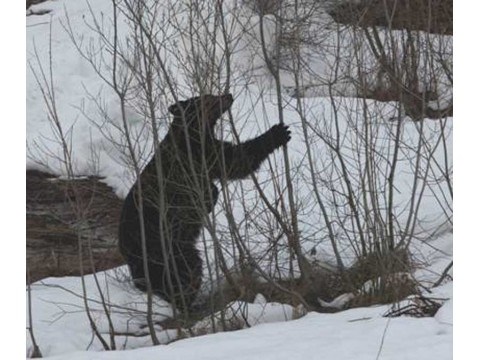I stand 44 metres from a busy blue run on a warm spring day. Skiers and riders dot the high elevation taking advantage of the 300-cm powder packed slope.
Kicking off my skis to anthropogenic chatter, in an otherwise wilderness solitude is an odd feeling. Because what I am about to do, is delve into one of the most secretive realms in nature before an audience oblivious to the fact.
Four metres upslope and 2.5 metres beneath the snow, inside the hollow basal cavity of an old growth yellow cedar tree snag (dead standing tree) is an immature female (< 4 years) black bear in hibernation.
The soft swish from a carving snowboarder draws my glance through the buffer of sub-alpine fir forest.
From five metres away I first photograph the snow-covered den to record snow depth from uphill and downhill. On the down side of the 98 cm wide tree, I gently brush away about 30 cm of snow exposing the top of a 8x30 cm size crack. I illuminate the position of the 40 kg immature female bear. A ridge of black guard hair outlines the semi-prone position with her snout lying between forepaws. Through the crack, all that's visible is the left side of the head, forepaw, and shoulder.
I move the light posterior to the left shoulder and wait for the rise of the visible portion of chest. I click my stopwatch as the chest expands... six seconds later the chest collapses. She takes another breath 44 seconds later. During hibernation bears take breaths from every 35 to 55 seconds.
I slide a 100 cm long temperature probe about a foot above her body and leave it for four minutes. The thermometer reads -4 with the ambient (outside of tree) temperature at +2 degrees Celcius. As any Grade 5 student will tell you, dens do not (directly) keep bears warm. Bears maintain warmth from their large surface area covered in a dual-layer thick coat, near normal body temperature, and the solid buffer of wood protected by snow to keep the den cavity dry.
Over 80 per cent of the 400 dens I've surveyed throughout the Coast Mountains are inside dead or dying trees. Bears have also denned beneath large boulders or outcrops, the root mass of blown-down trees or large standing stumps, and debris piles of logging slash.
I gently brush the snow back into place, closing the brief window to her slumbering world. With a peak snowpack still of 250 cm insulating the bear from coming spring temperatures, it will be two-three weeks before she emerges.
I return to my skis and slide down 250 metres to another den. This one is vacant but still I consider it important to photograph snow depth and inspect to what degree the cavity is or is not filled with snow. Bears mostly use different dens each winter, either constructing a new tree cavity or finding a "fixer-upper" previously used by another bear or sometimes by the same bear, years later.
Male bears began emerging from dens in mid-March. April is the main window of emergence for single females and females with yearlings (2009 births). Mothers with cubs-of-the-year (COY: 2010 births) emerge last, usually by mid-May. Females give birth about mid-January to early February.
Out of the den, bears remain lethargic and sleep most of the day at daybeds close to water or feeding areas. First foods are skunk cabbage shoots, pussy willows and new green-up. It would be a good idea now, to remove bird feeders and keep garbage secure to give bears a healthy start to their season.
2010 marks my 17 th year of studying black bears in Whistler. Core research is conducted in the Whistler-Blackcomb ski area through photo-identification and commercial bear viewing surveys. Life-history mapping of 20 adult females is the objective, recording cub production, mortality, breeding behavior, foraging patch densities and behavioral ecology. I am an independent researcher working as the senior bear viewing guide at Whistler-Blackcomb. Research supports bear education programs including classroom, field excursions, bear viewing, media outreach and visitor lecture series.




